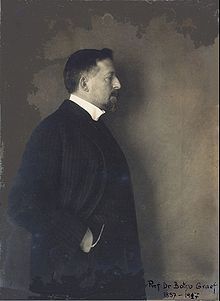Botho Graef
Franz Botho Graef (born October 12, 1857 in Berlin , † April 9, 1917 in Königstein im Taunus ) was a German classical archaeologist and art historian .
life and work
Botho Graef came from a Berlin artist family. His father Gustav Graef was a well-known portrait painter . His mother Franziska Graef (1824–1893), who came from the important Jewish Liebreich family, was also a painter and lithographer . Graef studied classical philology and classical archeology at the Friedrich-Wilhelms-Universität zu Berlin and the Ernst-Moritz-Arndt-Universität Greifswald . During his studies he took part in excavation and research trips to Italy, Greece and Asia Minor. Through his sister, the painter Sabine Lepsius , he had contact with the George Circle in Berlin . He also exchanged letters with Stefan George . In 1886 he was with the dissertation De Bacchi expeditione indica Monumentis expressa doctorate . From 1890 to 1904 he was a private lecturer at the Friedrich Wilhelms University.
From 1904 to 1917 Graef taught classical archeology and art history as an associate professor at the University of Jena . He was a member of the university's building committee. The university and city of Jena owe works by Ferdinand Hodler , Henry van de Velde and Auguste Rodin to his advocacy . He was a mentor of the Jena Art Association founded in 1903 . As a friend and sponsor, he paved the way for artists such as Emil Nolde and Ernst Ludwig Kirchner . For Nolde he set up exhibitions at the Jenaer Kunstverein; Graef was a fatherly friend to Kirchner, whom he portrayed several times. In 1916 Graef wrote to various patrons to finance a sanatorium for Kirchner, as he expected "that he might live in a helpless state like Nietzsche for years". After Graef's death, Henry van de Velde sought out the sick Kirchner in Davos in “thinking” of him. Velde won his trust and organized his recovery through the Bellevue sanatorium .
Graef died in 1917 of a heart attack in Koenigstein, a health resort that his brother-in-law Reinhold Lepsius and Kirchner often visited and in the latter, wall paintings in the fountain tower of the sanatorium by Dr. Oskar Kohnstamm created. In 1917 Kirchner donated 260 woodcuts , lithographs and etchings to the Jenaer Kunstverein in memory of Botho Graef . The Botho Graef Foundation became the most valuable part of the Jena art collection. Karl Gustav Vollmoeller and Walter Dexel were among Graef's well-known students .
In recognition of Botho Graef and his commitment to modern art, the city of Jena has been awarding the Botho Graef Prize to contemporary artists since 1992 .
Exhibitions
- 2017: There is only one program: freedom. On the 100th anniversary of Botho Graef's death . Art collection Jena .
Fonts
Essays
- To the sculptures of Olympia . In: Communications from the German Archaeological Institute, Athenian Department . Volume 13, 1888, pp. 402-407 ( digitized version ).
- Herakles des Scopas and allies . In: Communications of the German Archaeological Institute, Roman Department . Volume 4, 1889, pp. 189–226 ( digitized version )
- The group of tyrannicide and stylistically related works in Athens . In: Communications from the German Archaeological Institute, Athenian Department. Volume 15, 1890, pp. 1-39 ( digitized version ).
Monographs
- [Hodler's and Hofmann's murals in the University of Jena . Eugen Diederichs, Jena 1910.
- Henry van de Velde In: The bookworm. Monthly for book lovers. Verlag der Bücherwurm, Dachau 1913.
- together with Ernst Langlotz : The antique vases from the Acropolis in Athens. Volumes 1–2, de Gruyter, Berlin 1925–1933 (posthumously).
literature
- Friedrich Matz the Younger : Graef, Botho. In: New German Biography (NDB). Volume 6, Duncker & Humblot, Berlin 1964, ISBN 3-428-00187-7 , p. 708 f. ( Digitized version ).
- Annette Dorgerloh : The artist couple Lepsius. On Berlin portrait painting around 1900. Akademie-Verlag, Berlin 2003, ISBN 3-05-003722-9 .
- Günther Gercken: The Botho Graef Foundation. Monument and self-expression. In: Intoxication and disenchantment. The picture collection of the Jenaer Kunstverein - fate of a collection of the avant-garde in the 20th century. Edited by Jenaer Kunstverein eV Bussert & Stadeler, Jena / Quedlinburg 2008, pp. 45–50.
Web links
- Botho Graef Art Prize of the City of Jena
- Literature by and about Botho Graef in the catalog of the German National Library
- Botho Graef at Google Books
Individual evidence
- ↑ According to research by the registry office, Botho Graef was not entered in the death register of the city of Königstein in 1917.
- ^ After a letter from his sister to Eberhard Grisebach , Graef was buried in Königstein. From: Lothar Grisebach: From Munch to Kirchner - Experienced art history in letters from the estate of Eberhard Grisebach. Munich 1968, p. 63.
- ^ Sabine Lepsius: Stefan George, story of a friendship. Publishing house Die Runde, Berlin 1935.
- ↑ Berthold Vallentin (Ed.): Conversations with Stefan George 1902-1931 Wallstein Verlag, Göttingen 2008, ISBN 978-3-8353-0390-4 , p. 90.
- ^ Lothar Grisebach: From Munch to Kirchner - Experienced art history in letters from the estate of Eberhard Grisebach. Munich 1968, p. 51.
- ↑ Henry van de Velde: Story of my life. Munich 1962, p. 391.
- ↑ Biography Kirchnermuseum ( Memento from February 9, 2014 in the Internet Archive ) (PDF; 181 kB)
| personal data | |
|---|---|
| SURNAME | Graef, Botho |
| ALTERNATIVE NAMES | Graef, Franz Botho |
| BRIEF DESCRIPTION | German classical archaeologist and art historian |
| DATE OF BIRTH | October 12, 1857 |
| PLACE OF BIRTH | Berlin |
| DATE OF DEATH | April 9, 1917 |
| Place of death | Königstein im Taunus |


